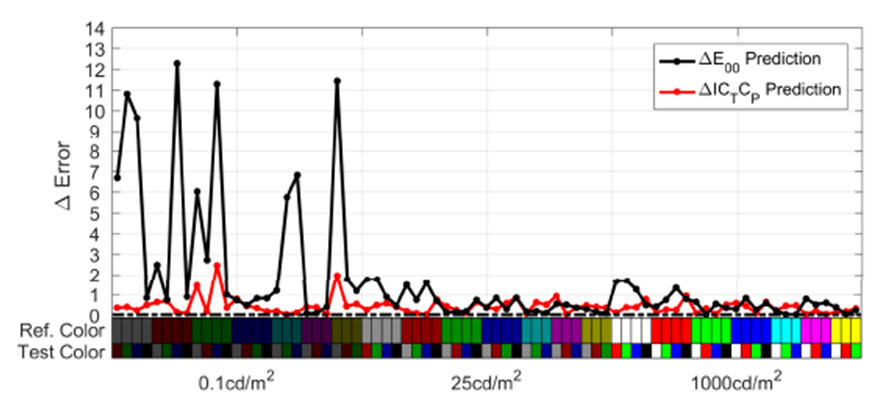Elizabeth Pieri and Jaclyn Pytlarz from Dolby Laboratories started their presentation by saying that the common color accuracy metric, delta E2000 (based on CIELAB), is actually not that accurate when used on HDR displays, since it is based on evaluation of reflective surfaces and a limited light levels. Other color accuracy metrics based on CIELUV or CAM02-USC have been developed for SDR displays, but have not been validated for HDR displays. These errors can lead to poor design decisions and problems with calibration. Their presentation described new tests done on HDR displays using a new metric: delta ICtCp to describe HDR and WCG color accuracy.
Pieri and Pylarz defined this new metric as:

Their experimental work was geared toward developing a new set of data points for HDR JNDs (Just Noticeable Differences). A JND describes how different two colors are in order to be perceivable by the average human. Several datasets exist for SDR colors (MacAdam, RIT-DuPont and others), but not for HDR displays.
For the experiments, an RGB laser projector with primaries near BT.2020 was used. Several colors (RGBCYMW) were tested at 3 luminance levels (0.1, 25 and 1000 cd/m²). Colors were then presented along the vectors shown in the figure below (white toward the primaries and colors toward white), with care taken to maintain luminance along these vectors.
Observers sat in a cinema at a distance of about 30 feet (9m) and were shown four patches of colors, with one being different. 69 observers were given a color vision test (2 were eliminated) and were then asked to identify the different color. All 67 did not view all colors in all directions, however.
Three error statistics were used as evaluators of performance (low numbers are better). Test data comparing delta E2000 to delta ICtCp is shown below. Delta E2000 overestimates the error for the dark colors and underperforms in the mid and bright ranges as well. Other metrics were analyzed with performance in between these two.

The paper also provides some additional analysis on these results but it does not change the conclusion that delta ICpCt offers the best JND metric. The team did not go so far as to propose tolerances for HDR monitors but they did suggest that using delta u*v*, which is recommended by the EBU for reference monitors, will perform like deltaE2000.
In follow-up questions, the two noted that they did not see much of an impact of metamerism as there were consistent responses among the observers. They also said that they did use very saturated colors because it was an RGB laser projector, but previous work suggested the results would be similar if less saturated colors were used. In the future, they hope to continue testing to evaluate memory colors and skin tones – CC.

